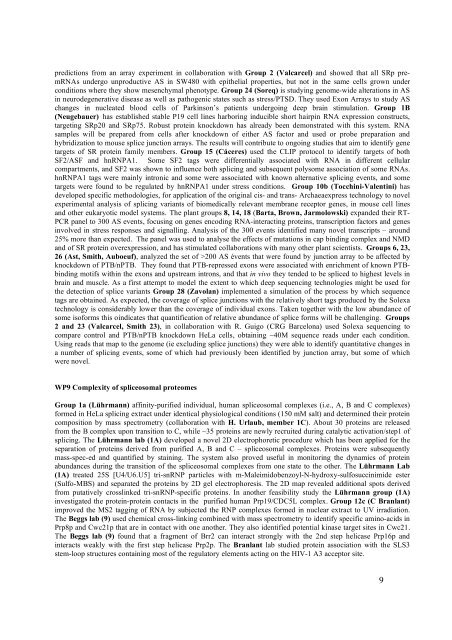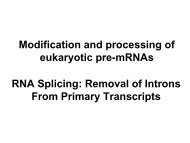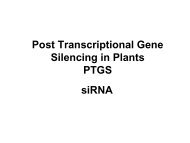You also want an ePaper? Increase the reach of your titles
YUMPU automatically turns print PDFs into web optimized ePapers that Google loves.
predictions from an array experiment in collaboration with Group 2 (Valcarcel) and showed that all SRp premRNAsundergo unproductive AS in SW480 with epithelial properties, but not in the same cells grown underconditions where they show mesenchymal phenotype. Group 24 (Soreq) is studying genome-wide alterations in ASin neurodegenerative disease as well as pathogenic states such as stress/PTSD. They used Exon Arrays to study ASchanges in nucleated blood cells of Parkinson’s patients undergoing deep brain stimulation. Group 1B(Neugebauer) has established stable P19 cell lines harboring inducible short hairpin RNA expression constructs,targeting SRp20 and SRp75. Robust protein knockdown has already been demonstrated with this system. RNAsamples will be prepared from cells after knockdown of either AS factor and used or probe preparation andhybridization to mouse splice junction arrays. The results will contribute to ongoing studies that aim to identify genetargets of SR protein family members. Group 15 (Cáceres) used the CLIP protocol to identify targets of bothSF2/ASF and hnRNPA1. Some SF2 tags were differentially associated with RNA in different cellularcompartments, and SF2 was shown to influence both splicing and subsequent polysome association of some RNAs.hnRNPA1 tags were mainly intronic and some were associated with known alternative splicing events, and sometargets were found to be regulated by hnRNPA1 under stress conditions. Group 10b (Tocchini-Valentini) hasdeveloped specific methodologies, for application of the original cis- and trans- Archaeaexpress technology to novelexperimental analysis of splicing variants of biomedically relevant membrane receptor genes, in mouse cell linesand other eukaryotic model systems. The plant groups 8, 14, 18 (Barta, Brown, Jarmolowski) expanded their RT-PCR panel to 300 AS events, focusing on genes encoding RNA-interacting proteins, transcription factors and genesinvolved in stress responses and signalling. Analysis of the 300 events identified many novel transcripts – around25% more than expected. The panel was used to analyse the effects of mutations in cap binding complex and NMDand of SR protein overexpression, and has stimulated collaborations with many other plant scientists. Groups 6, 23,26 (Ast, Smith, Auboeuf), analyzed the set of >200 AS évents that were found by junction array to be affected byknockdown of PTB/nPTB. They found that PTB-repressed exons were associated with enrichment of known PTBbindingmotifs within the exons and upstream introns, and that in vivo they tended to be spliced to highest levels inbrain and muscle. As a first attempt to model the extent to which deep sequencing technologies might be used forthe detection of splice variants Group 28 (Zavolan) implemented a simulation of the process by which sequencetags are obtained. As expected, the coverage of splice junctions with the relatively short tags produced by the Solexatechnology is considerably lower than the coverage of individual exons. Taken together with the low abundance ofsome isoforms this oindicates that quantification of relative abundance of splice forms will be challenging. Groups2 and 23 (Valcarcel, Smith 23), in collaboration with R. Guigo (CRG Barcelona) used Solexa sequencing tocompare control and PTB/nPTB knockdown HeLa cells, obtaining ~40M sequence reads under each condition.Using reads that map to the genome (ie excluding splice junctions) they were able to identify quantitative changes ina number of splicing events, some of which had previously been identified by junction array, but some of whichwere novel.WP9 Complexity of spliceosomal proteomesGroup 1a (Lührmann) affinity-purified individual, human spliceosomal complexes (i.e., A, B and C complexes)formed in HeLa splicing extract under identical physiological conditions (150 mM salt) and determined their proteincomposition by mass spectrometry (collaboration with H. Urlaub, member 1C). About 30 proteins are releasedfrom the B complex upon transition to C, while ~35 proteins are newly recruited during catalytic activation/step1 ofsplicing. The Lührmann lab (1A) developed a novel 2D electrophoretic procedure which has been applied for theseparation of proteins derived from purified A, B and C – spliceosomal complexes. Proteins were subsequentlymass-spec-ed and quantified by staining. The system also proved useful in monitoring the dynamics of proteinabundances during the transition of the spliceosomal complexes from one state to the other. The Lührmann Lab(1A) treated 25S [U4/U6.U5] tri-snRNP particles with m-Maleimidobenzoyl-N-hydroxy-sulfosuccinimide ester(Sulfo-MBS) and separated the proteins by 2D gel electrophoresis. The 2D map revealed additional spots derivedfrom putatively crosslinked tri-snRNP-specific proteins. In another feasibility study the Lührmann group (1A)investigated the protein-protein contacts in the purified human Prp19/CDC5L complex. Group 12c (C Branlant)improved the MS2 tagging of RNA by subjected the RNP complexes formed in nuclear extract to UV irradiation.The Beggs lab (9) used chemical cross-linking combined with mass spectrometry to identify specific amino-acids inPrp8p and Cwc21p that are in contact with one another. They also identified potential kinase target sites in Cwc21.The Beggs lab (9) found that a fragment of Brr2 can interact strongly with the 2nd step helicase Prp16p andinteracts weakly with the first step helicase Prp2p. The Branlant lab studied protein association with the SLS3stem-loop structures containing most of the regulatory elements acting on the HIV-1 A3 acceptor site.9







